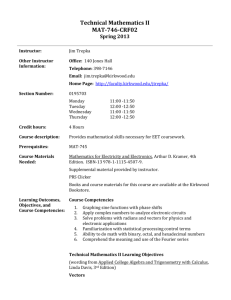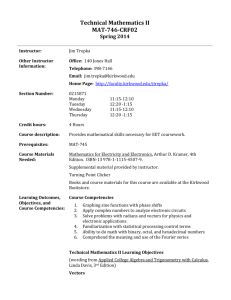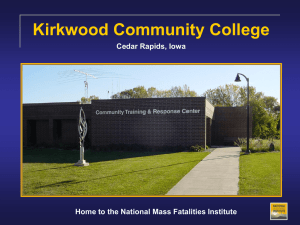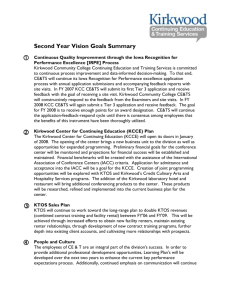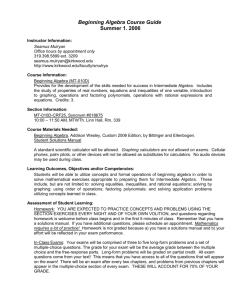Tech Math II_Syllabus.doc - Kirkwood Community College
advertisement
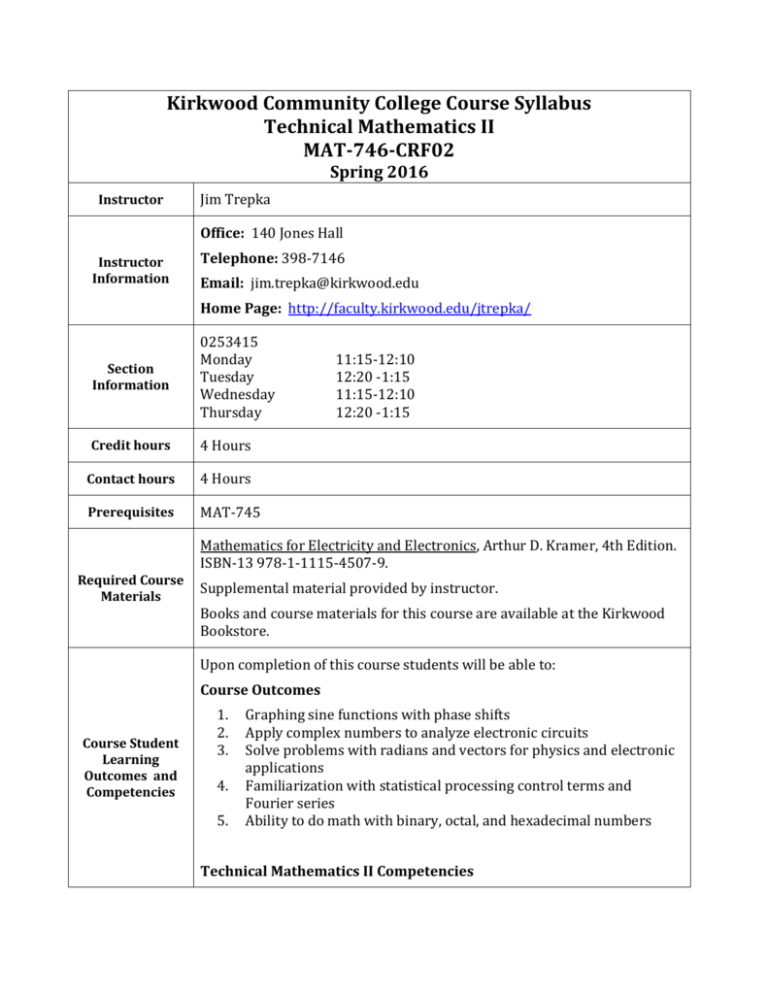
Kirkwood Community College Course Syllabus Technical Mathematics II MAT-746-CRF02 Spring 2016 Instructor Jim Trepka Office: 140 Jones Hall Instructor Information Telephone: 398-7146 Email: jim.trepka@kirkwood.edu Home Page: http://faculty.kirkwood.edu/jtrepka/ Section Information 0253415 Monday Tuesday Wednesday Thursday Credit hours 4 Hours Contact hours 4 Hours Prerequisites MAT-745 11:15-12:10 12:20 -1:15 11:15-12:10 12:20 -1:15 Mathematics for Electricity and Electronics, Arthur D. Kramer, 4th Edition. ISBN-13 978-1-1115-4507-9. Required Course Materials Supplemental material provided by instructor. Books and course materials for this course are available at the Kirkwood Bookstore. Upon completion of this course students will be able to: Course Outcomes Course Student Learning Outcomes and Competencies 1. 2. 3. 4. 5. Graphing sine functions with phase shifts Apply complex numbers to analyze electronic circuits Solve problems with radians and vectors for physics and electronic applications Familiarization with statistical processing control terms and Fourier series Ability to do math with binary, octal, and hexadecimal numbers Technical Mathematics II Competencies (wording from Applied College Algebra and Trigonometry with Calculus, Linda Davis, 3rd Edition) Vectors 1. Find the resultant of a given set of vectors. 2. Use vectors to solve problems in science and technology. 3. Apply the Law of Sines to solve oblique triangles. 4. Apply the Law of Cosines to solve oblique triangles. 5. Apply the Law of Sines and Law of Cosines to solve technical problems. Trig Graphs 1. Identify the amplitude, period, and phase angle of a sine or cosine trigonometric function. 2. Sketch the graph of a sine or cosine function using its amplitude, period, and phase angle. 3. Apply the concept of amplitude, period, and phase shift to simple harmonic motion and ac circuits. Trigonometric Functions of Any Angle 1. Determine the sign of a trigonometric function in any of the four quadrants. 2. Determine the reference angle for an angle whose terminal side lies in any quadrant. 3. Find the value of the trigonometric functions for any given angle. 4. Convert angles measure in degrees to radians and vice versa. 5. Find the value of a trigonometric function given an angle measure in radians and vice versa. 6. Apply radian measure to finding the length of a circular arc, the area of a circular sector, and angular and linear velocity. Complex Numbers 1. Add, subtract, multiply, and divide imaginary numbers. 2. Simplify powers of the imaginary number j. 3. Add, subtract, multiply, and divide complex numbers in a rectangular form. 4. Convert complex numbers among rectangular, polar, and exponential forms. 5. Use polar and exponential forms to find the product, quotient, power, and roots of complex numbers. 6. Apply the concept of complex numbers to ac circuits. Statistics 1. Organize data into a frequency distribution and give a graphical representation using a histogram or a frequency polygon. 2. Calculate the arithmetic mean, median, and mode from empirical data. 3. Calculate the range and standard deviation from empirical data. 4. Use the mean and standard deviation to calculate the variation of data values that should fall within one or two standard deviations of the mean. 5. Use the least squares method to fit empirical data to an equation. Technical Mathematics II Learning Objectives (Wording from Electronic Mathematics by Thomas C. Power; Delmar Publishers Inc.) Math for the Computer Identify numbering systems Convert base 10 to binary, octal and hexadecimal Convert binary, octal, and hexadecimal to base 10 Convert binary to octal Convert octal to binary Convert binary to hexadecimal Convert hexadecimal to binary Convert decimal fractions to binary and octal fractions Convert binary and octal fractions to decimal fractions Add binary numbers Subtract binary numbers by complementation Technical Mathematics II Learning Objectives (Wording from Circuit Analysis with Devices: Theory and Practice, Robbins & Miller, 4th Edition, Delmar Learning.) Fourier series 1. Use tables to write the Fourier equivalent of any simple periodic waveform 2. Sketch the frequency spectrum of a periodic waveform, giving the amplitudes of various harmonics in either volts, watts, or dBm. 3. Determine the output of a filter circuit given the frequency spectrum of the input signal and the frequency response of the filter. ADDITIONAL OBJECTIVES Statistical Process Control - What they mean and why / where you would use them: Average, Mean, Median, Normal (Gaussian) distribution, Normal distribution, Bimodal distribution, Standard Deviations, 3-Sigma and 6Sigma, Histogram, Random Sample, Probability Density Function, Mean Squared Error, Outlier, Bias and systematic error, Sample Size, Statistical Process Control, Cp, Cpk (USL, LSL) Late Work/Make-up Test Policy All work is due on its due date and will receive a zero otherwise. Late work may be accepted at the discretion of the instructor in extremely rare circumstances. lass Attendance Policy and College Sponsored Activities Productive Classroom Learning Environment Plagiarism Policy As stated in the Student handbook: In compliance with Public Law 105-244, Kirkwood Community College makes a wide variety of general institutional information available to students. For additional information, go to: http://www.kirkwood.edu/site/index.php?p=32303 We believe that the best learning takes place in an environment where faculty and students exhibit trust and mutual respect. In a productive learning environment, faculty and students work cooperatively, recognize and respect differences, model the values of character and citizenship, and become lifelong learners. Kirkwood Community College is a community of shared values, foremost of which is a strong commitment to academic integrity, honorable conduct, and respect for others. Through the honest completion of academic work, students sustain the integrity of the college and promote a culture of civility, fairness, trust, and respect among its members. Those who violate these standards must be held responsible. Kirkwood students are responsible for authenticating all work in a course. This includes but is not limited to quizzes, exams, presentations, papers, journals, and projects. For this reason, it is recommended that students engage in a verifiable working process on assignments and conduct themselves during class in a manner that does not lead to the suspicion of academic dishonesty. Examples of Academic Dishonesty include but are not limited to: Plagiarism and Fabrication, Misrepresentation, Cheating and Facilitation, and Impeding Fair and Equal Access to the Education and Research Process. It is the student’s responsibility to be aware of the behaviors that constitute academic dishonesty. A detailed description of this policy and the sanctions associated with it can be found here: http://www.kirkwood.edu/site/index.php?p=32303 Campus Closings Academic Accommodations Counseling and Career Services See Student Policies: General Policies and Student Rights http://www.kirkwood.edu/site/index.php?p=32309 Students with specific academic and/or classroom needs may request individualized accommodations. Students wishing to request accommodations should complete an ‘Accommodation Request Form’ which is available at the Learning Services office, 2063 Cedar Hall, or online at www.kirkwood.edu/accommodations. Students will be asked to provide documentation supporting their request. An accommodation plan must be completed each semester and given to instructors before academic accommodations will be provided. Free, confidential counseling services are available for Kirkwood Community College students seeking career direction, academic support and individual counseling. While college years are a time of personal growth, this time can be accompanied by accelerated change and significant challenges that often bring considerable stress. Counselors promote student emotional and intellectual well – being. Call 319-398-5540 or visit www.kirkwood.edu/counseling to learn more. Midterm grades A midterm grade will be calculated and posted on EagleNet. The midterm grade is a grade-in-progress, and will not affect your official GPA, nor will it impact financial aid. The midterm grade has three purposes: first, to communicate your academic performance; second, to provide opportunities for you to discuss your progress with your instructor; and third, to allow Kirkwood to design collegewide intervention programs that will improve student success. For any given unit exam, you can chose to go with Option #1 or Option #2 Option #1: Unit Exams - Exams will be given after every chapter totaling 75% of your final grade. Missed exams must be made up on or before the next class period. In a rare situation where the exam can not be made up in that time period, the student will need to make up the exam during the final exam week and this exam will be different than that taken by the rest of the class. Option #2: Unit Exams - Exams will be given after every chapter totaling 50% of your final grade. Missed exams must be made up on or before the next class period. In a rare situation where the exam can not be made up in that time period, the student will need to make up the exam during the final exam week and this exam will be different than that taken by the rest of the class. Student Evaluation Homework - Homework will be assigned on a daily basis. Homework will be worth 25% of your final grade. Homework assignments can be found at http://faculty.kirkwood.edu/site/index.php?p=18799 . Homework will be due the day of the exam. For Both Options: Final Exam - The final exam will be worth 25% of your final grade. Class Room Participation, and Professional Conduct Points will be deducted from the your final grade for the following: 1. Inappropriate language or jokes. 2. Ringing of cell phones in class. 3. Disrupting the class. 4. Leaving class early. 5. Not cleaning up workspace at the end of the class. After earning the Associates of Applied Science in Electronics Engineering Technology at Kirkwood Community College, you may be working with people from substantially different backgrounds than your own. Since the Electronics Engineering Technology program is a career tech program, respect for differences in the workplace will be a skill that will be fostered in this program. You will be expected to show respect for those from different nationalities, religions, gender, sexual orientations, and learning abilities. This respect is expected during class, between class, and after class. In other words, anytime you are in Jones Hall or its vicinity (i.e. parking lot, sidewalks, etc.). These are the same expectations that some area employers have. Your final grade will be negatively impacted by each violation of this policy. Grading Scale A 94 - 100 C 73 – 76.99 A- 90 – 93.99 C- 70 – 72.99 B+ 87 – 89.99 D+ 67 – 69.99 B 83 – 86.99 D 63 – 66.99 B- 80 – 82.99 D- 60 – 62.99 C+ 77 – 79.99 F 59.99 and less To find the last day to get a refund, go to EagleNet for Students, then Search for Sections, then click the link for this term’s Last Day to Drop list. https://eaglenet.kirkwood.edu/production/WebAdvisor?TOKENIDX=9443580219&typ e=M&constituency=WBST&pid=CORE-WBST Drop Date The last date to drop this class for this term is April 22, 2016. Details of the refund schedule can be found under Academic & Enrollment Policies at: http://www.kirkwood.edu/catalog/2014-2015/refund-of-tuition_0.htm Final Exam Information Final exams are scheduled during the last week of the term from May 4 to May 10. The final exam for this class is scheduled on Thursday May 5 at 10:10 am. See Facilities: Emergency/Crisis Information Emergency Information http://www.kirkwood.edu/site/index.php?p=7987 Other Information Check Refund Policy at: www.kirkwood.edu/registration [If desired, list emergency phone numbers, department office locations, etc.] Rev. 4/11 -- Rev. 5/11 -- Rev. 6/12 Rev. 8/14/12 -- Rev. 1/22/14 -- Rev. 7/29/14 Rev. 3/10/15 – Rev. 9/2/15
